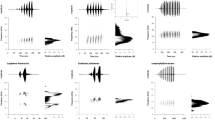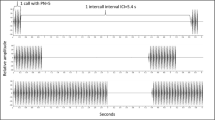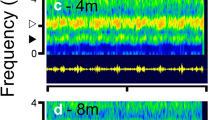Abstract
A common form of signal competition in acoustically chorusing animals involves the precise timing of calls relative to those of other nearby individuals. In this study, I present a detailed description of nonrandom timing of both advertisement and aggressive calls in males of the Neotropical treefrog Dendropsophus ebraccatus. I used playback tests to measure call delays for both advertisement and aggressive calls given in response to synthetic advertisement and aggressive call stimuli presented with either a fixed or random timing arrangement. Call delays for a given response call type were nonrandomly distributed and did not differ depending on the fixed or random periodicity of stimulus presentation or on the stimulus call type. In general, advertisement call responses overlapped the playback stimuli, while aggressive calls were given with a much longer delay and did not overlap the playback stimuli. A second test involved the presentation of low pulse number advertisement and aggressive call stimuli to determine if males were capable of nonrandom timing to truncated stimuli. These playbacks also assessed whether they responded more aggressively to truncated aggressive call stimuli. Males usually showed synchrony in response to truncated calls of both types, more commonly in response to truncated advertisement calls. There were no differences in aggressive responses to truncated advertisement or aggressive calls. Call delays appear to be a property solely of the type of call that the male produces, regardless of the kind of stimulus. Thus, there may be a conflict between the ability to discriminate between signals and the ability to rapidly respond to these signals with an appropriate call delay.




Similar content being viewed by others
References
Bee MA, Bowling AC (2002) Socially mediated pitch alteration by territorial male bullfrogs, Rana catesbeiana. J Herpetol 36:140–143
Berens P (2009) CircStat: a MATLAB toolbox for circular statistics. J Stat Softw 31:1–21
Brush JS, Narins PM (1989) Chorus dynamics of a neotropical amphibian assemblage: comparison of computer simulation and natural behaviour. Anim Behav 37:33–44
Buck J (1988) Synchronous rhythmic flashing of fireflies. II. Q Rev Biol 63:265–289
Fisher NI, Lewis T (1983) Estimating the common mean direction of several circular or spherical distributions with differing dispersions. Biometrika 70:333–341
Gayou DC (1984) Effects of temperature on the mating call of Hyla versicolor. Copeia 1984:733–738
Gerhardt HC, Huber F (2002) Acoustic communication in insects and anurans. The University of Chicago Press, Chicago
Given MF (1987) Vocalizations and acoustic interactions of the carpenter frog, Rana virgatipes. Herpetologica 43:467–481
Grafe TU (1996) The function of call alternation in the African reed frog (Hyperolius marmoratus): precise call timing prevents auditory masking. Behav Ecol Sociobiol 38:149–158
Grafe TU (1999) A function of synchronous chorusing and a novel female preference shift in an anuran. Proc R Soc Lond B Biol Sci 266:2331–2336
Grafe TU (2003) Synchronized interdigitated calling in the Kuvangu running frog, Kassina kuvangensis. Anim Behav 66:127–136
Greenfield MD (1994a) Cooperation and conflict in the evolution of signal interactions. Annu Rev Ecol Syst 25:97–126
Greenfield MD (1994b) Synchronous and alternating choruses in insects and anurans—common mechanisms and diverse functions. Am Zool 34:605–615
Greenfield MD (2002) Signalers and receivers. Oxford University Press, Oxford
Greenfield MD, Roizen I (1993) Katydid synchronous chorusing is an evolutionarily stable outcome of female choice. Nature 364:618–620
Greenfield MD, Tourtellot MK, Snedden WA (1997) Precedence effects and the evolution of chorusing. Proc R Soc Lond B Biol Sci 264:1355–1361
Hartbauer M, Kratzer S, Steiner K, Römer H (2005) Mechanisms for synchrony and alternation in song interactions of the bushcricket Mecopoda elongata (Tettigoniidae: Orthoptera). J Comp Physiol A 191:175–188
Höbel G, Gerhardt HC (2007) Sources of selection on signal timing in a tree frog. Ethology 113:973–982
Jones MDR (1966a) The acoustic behaviour of the bush cricket Pholidoptera griseoaptera: I. Alternation, synchronism and rivalry between males. J Exp Biol 45:15–30
Jones MDR (1966b) The acoustic behaviour of the bush cricket Pholidoptera griseoaptera: II. Interaction with artificial sound signals. J Exp Biol 45:31–44
Klump GM, Gerhardt HC (1992) Mechanisms and function of call timing in male–male interactions in frogs. In: McGregor PK (ed) Playback and studies of animal communication. Plenum, New York, pp 153–174
Kotiaho JS, Alatalo RV, Mappes J, Parri S (2004) Adaptive significance of synchronous chorusing in an acoustically signalling wolf spider. Proc R Soc Lond B Biol Sci 271:1847–1850
Minckley RL, Greenfield MD, Tourtellot MK (1995) Chorus structure in tarbush grasshoppers—inhibition, selective phonoresponse and signal competition. Anim Behav 50:579–594
Moore SW, Lewis ER, Narins PM, Lopez PT (1989) The call-timing algorithm of the white-lipped frog, Leptodactylus albilabris. J Comp Physiol A 164:309–319
Naguib M, Mennill DJ (2010) The signal value of birdsong: empirical evidence suggests song overlapping is a signal. Anim Behav 80:e11–e15
Narins PM (1982) Behavioral refractory period in Neotropical treefrogs. J Comp Physiol 148:337–344
Nityananda V, Balakrishnan R (2007) Synchrony during acoustic interactions in the bushcricket Mecopoda ‘Chirper’ (Tettigoniidae:Orthoptera) is generated by a combination of chirp-by-chirp resetting and change in intrinsic chirp rate. J Comp Physiol A 193:51–65
Penna M, Narins PM, Feng AS (2005) Thresholds for evoked vocal responses of Eupsophus emiliopugini (Amphibia, Leptodactylidae). Herpetologica 61:1–8
Rand AS, Ryan MJ (1981) The adaptive significance of a complex vocal repertoire in a Neotropical frog. Z Tierpsychol 57:209–214
Reichert M (2010) Aggressive thresholds in Dendropsophus ebraccatus: habituation and sensitization to different call types. Behav Ecol Sociobiol 64:529–539
Reichert M (2011a) Effects of multiple-speaker playbacks on aggressive calling behavior in the treefrog Dendropsophus ebraccatus. Behav Ecol Sociobiol 65:1739–1751
Reichert MS (2011b) Aggressive calls improve leading callers’ attractiveness in the treefrog Dendropsophus ebraccatus. Behav Ecol 22:951–959
Richardson C, Lena J-P, Joly P, Lengagne T (2008) Are leaders good mates? A study of call timing and male quality in a chorus situation. Anim Behav 76:1487–1495
Rosen M, Lemon RE (1974) Vocal behavior of spring peepers, Hyla crucifer. Copeia 1974:940–950
Ryan MJ (1986) Synchronized calling in a treefrog (Smilisca sila). Brain Behav Evol 29:196–206
Schwartz JJ (1987) The function of call alternation in anuran amphibians: a test of three hypotheses. Evolution 41:461–471
Schwartz JJ (1991) Why stop calling? A study of unison bout singing in a Neotropical treefrog. Anim Behav 42:565–577
Schwartz JJ, Buchanan B, Gerhardt HC (2002) Acoustic interactions among male gray treefrogs, Hyla versicolor, in a chorus setting. Behav Ecol Sociobiol 53:9–19
Schwartz JJ, Wells KD (1984) Interspecific acoustic interactions of the Neotropical treefrog Hyla ebraccata. Behav Ecol Sociobiol 14:211–224
Sismondo E (1990) Synchronous, alternating, and phase-locked stridulation by a tropical katydid. Science 249:55–58
Tuttle MD, Ryan MJ (1982) The role of synchronized calling, ambient light, and ambient noise in anti-bat-predator behavior of a treefrog. Behav Ecol Sociobiol 11:125–131
Walker TJ (1969) Acoustic synchrony: two mechanisms in the snowy tree cricket. Science 166:891–894
Wells KD (1989) Vocal communication in a Neotropical treefrog, Hyla ebraccata: responses of males to graded aggressive calls. Copeia 1989:461–466
Wells KD, Schwartz JJ (1984a) Vocal communication in a Neotropical treefrog, Hyla ebraccata: advertisement calls. Anim Behav 32:405–420
Wells KD, Schwartz JJ (1984b) Vocal communication in a Neotropical treefrog, Hyla ebraccata: aggressive calls. Behaviour 91:128–145
Zar JH (2010) Biostatistical analysis, 5th edn. Pearson, Upper Saddle River
Zelick RD, Narins PM (1983) Intensity discrimination and the precision of call timing in two species of Neotropical treefrogs. J Comp Physiol 153:403–412
Acknowledgments
This work was supported by a Graduate Assistance in Areas of National Need fellowship from the University of Missouri and the U.S. Department of Education (P200A070476). Flavia Barbosa, Carl Gerhardt, and two anonymous reviewers provided helpful criticism on earlier versions of this paper. John Christy sponsored this project at the Smithsonian Tropical Research Institute. I would like to thank the STRI staff for their logistical assistance. Benjamin Nickelson and Daniel Gruhn assisted with call analyses. This article is part of Michael S. Reichert’s doctoral dissertation at the University of Missouri.
Ethical standards
These experiments comply with the current laws of the Republic of Panama and the United States of America. The Autoridad Nacional del Ambiente of the Republic of Panama provided permits for this work. The experimental protocol was approved by the Animal Care and Use Committee of the University of Missouri (ACUC protocol no. 1910).
Conflict of interest
The author declares that he has no conflict of interest.
Author information
Authors and Affiliations
Corresponding author
Additional information
Communicated by T. Bakker
Rights and permissions
About this article
Cite this article
Reichert, M.S. Call timing is determined by response call type, but not by stimulus properties, in the treefrog Dendropsophus ebraccatus . Behav Ecol Sociobiol 66, 433–444 (2012). https://doi.org/10.1007/s00265-011-1289-9
Received:
Revised:
Accepted:
Published:
Issue Date:
DOI: https://doi.org/10.1007/s00265-011-1289-9




